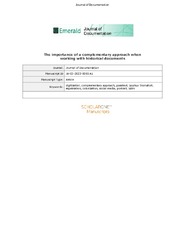| dc.contributor.author | Skare, Roswitha | |
| dc.date.accessioned | 2023-08-10T11:03:29Z | |
| dc.date.available | 2023-08-10T11:03:29Z | |
| dc.date.issued | 2023 | |
| dc.description.abstract | Purpose - The purpose of this study is to show that the neo-documentary – or complimentary – approach in Library and Information Science by no means is conservative, but highly necessary also in today’s digitized media landscape. An example from a digitized photo archive is chosen to demonstrate the importance of a complimentary analysis that considers both material aspects as well as social and mental ones. <p>
<p>Design/methodology/approach - By taking Jenna Hartel’s description of the neo-documentary turn as point of departure, the paper focuses on one case, the portrait of Johannes Abrahamsen Motka taken by Sophus Tromholt in 1883 and discusses different versions of the photograph from glass plate negatives to digitized versions in different contexts and media. <p>
<p>Findings - Many of the same paratextual elements can be found in different versions, also the digitized ones, to help the viewer to establish a historical context, but the images exhibited today are nevertheless no longer the same ones taken by Tromholt at the end of the 19th century. Not only have the material properties changed, but also – and probably even more important in most cases – the social and mental aspects. More re-contextualization is needed for today’s audiences to recognize and understand a historical photograph taken in a colonial context. Focusing on document’s material elements is not novel within the LIS-field, but the so-called neo-documentary turn was also a reaction on political and technological developments during the 1980s and 1990s. The increased focus on understanding a document in a complimentary way has demonstrated its impact during the last decades and is, at the same time, still work in progress. <p>
<p>Research limitations/implications - As a scholar in the humanities the author can only relate to and therefore analyze what the author can experience and observe on screen level. <p>
<p>Originality/value - In providing a case study, this article illustrates the necessity of employing a complimentary approach when analyzing historical documents. This also implicates the claim that the neodocumentary turn – or complimentary as it rather should be called – by no means is a conservative one, but a highly necessary one in today’s digitized media landscape. | en_US |
| dc.description | Source at <a href=https://www.emerald.com/insight/publication/issn/0022-0418>https://www.emerald.com/insight/publication/issn/0022-0418</a>. | en_US |
| dc.identifier.citation | Skare r. The importance of a complementary approach when working with historical documents. Journal of Documentation. 2023 | en_US |
| dc.identifier.cristinID | FRIDAID 2165761 | |
| dc.identifier.issn | 0022-0418 | |
| dc.identifier.issn | 1758-7379 | |
| dc.identifier.uri | https://hdl.handle.net/10037/29851 | |
| dc.language.iso | eng | en_US |
| dc.publisher | Emerald | en_US |
| dc.relation.journal | Journal of Documentation | |
| dc.rights.accessRights | openAccess | en_US |
| dc.rights.holder | Copyright 2023 The Author(s) | en_US |
| dc.rights.uri | https://creativecommons.org/licenses/by/4.0 | en_US |
| dc.rights | Attribution 4.0 International (CC BY 4.0) | en_US |
| dc.title | The importance of a complementary approach when working with historical documents | en_US |
| dc.type.version | acceptedVersion | en_US |
| dc.type | Journal article | en_US |
| dc.type | Tidsskriftartikkel | en_US |
| dc.type | Peer reviewed | en_US |


 English
English norsk
norsk
